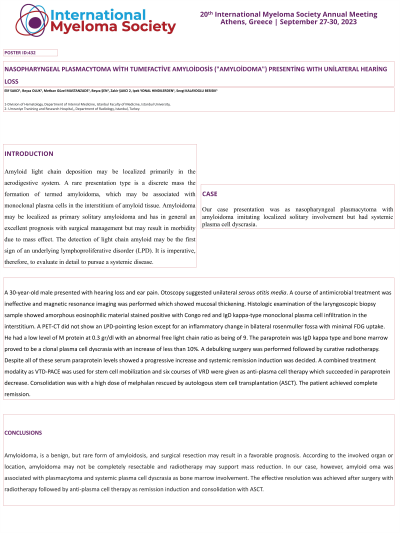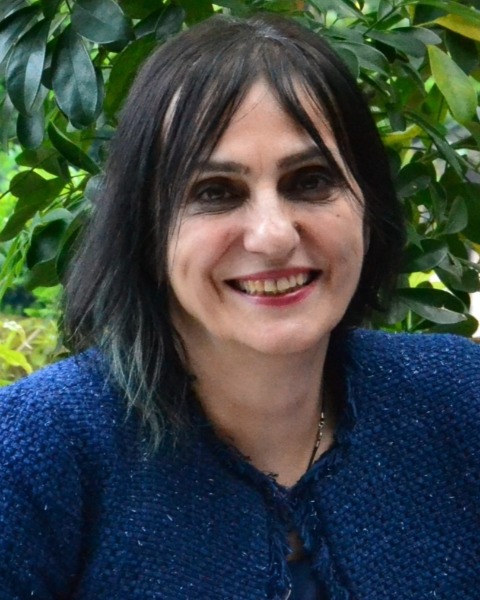Other plasma cell disorders
Poster Session 3
P-432: NASOPHARYNGEAL PLASMACYTOMA WİTH TUMEFACTİVE AMYLOİDOSİS ("AMYLOİDOMA") PRESENTİNG WITH UNİLATERAL HEARİNG LOSS
Friday, September 29, 2023
1:15 PM - 2:15 PM EEST


SEVGI KALAYOGLU-BESISIK
Professor
Istanbul University, Istanbul Faculty of Medicine/Department of Internal Medicine, Division of Hematology
Istanbul, Turkey
Introduction: Amyloid light chain deposition may be localized primarily in the aerodigestive system. A rare presentation type is a discrete mass the formation of termed amyloidoma, which may be associated with monoclonal plasma cells in the interstitium of amyloid tissue. Amyloidoma may be localized as primary solitary amyloidoma and has in general an excellent prognosis with surgical management but may result in morbidity due to mass effect. The detection of light chain amyloid may be the first sign of an underlying lymphoproliferative disorder (LPD). It is imperative, therefore, to evaluate in detail to pursue a systemic disease.
Methods: Our case presentation was as nasopharyngeal plasmacytoma with amyloidoma imitating localized solitary involvement but had systemic plasma cell dyscrasia.
Results: A 30-year-old male presented with hearing loss and ear pain. Otoscopy suggested unilateral serous otitis media. A course of antimicrobial treatment was ineffective and magnetic resonance imaging was performed which showed mucosal thickening. Histologic examination of laryngoscopic biopsy sample showed amorphous eosinophilic material stained positive with Congo red and IgD kappa-type monoclonal plasma cell infiltration in the interstitium. A PET-CT did not show an LPD-pointing lesion except for an inflammatory change in bilateral rosenmuller fossa with minimal FDG uptake. He had a low level of M protein at 0.3 gr/dl with an abnormal free light chain ratio as being of 9. The paraprotein was IgD kappa type and bone marrow proved to be a clonal plasma cell dyscrasia with an increase of less than 10%. A debulking surgery was performed followed by curative radiotherapy. Despite all of these serum paraprotein levels showed a progressive increase and systemic remission induction was decided. A combined treatment modality as VTD-PACE was used for stem cell mobilization and six courses of VRD was given as anti-plasma cell therapy which succeeded paraprotein decrease. Consolidation was with a high dose of melphalan rescued by autologous stem cell transplantation (ASCT). The patient achieved complete remission.
Conclusions: AAmyloidoma, is a benign, but rare form of amyloidosis, and surgical resection may result in a favorable prognosis. According to the involved organ or location, amyloidoma may not be completely resectable and radiotherapy may support mass reduction. In our case, however, amyloidoma was associated with plasmacytoma and systemic plasma cell dyscrasia as bone marrow involvement. The effective resolution was achieved after surgery with radiotherapy followed by anti-plasma cell therapy as remission induction and consolidation with ASCT
Methods: Our case presentation was as nasopharyngeal plasmacytoma with amyloidoma imitating localized solitary involvement but had systemic plasma cell dyscrasia.
Results: A 30-year-old male presented with hearing loss and ear pain. Otoscopy suggested unilateral serous otitis media. A course of antimicrobial treatment was ineffective and magnetic resonance imaging was performed which showed mucosal thickening. Histologic examination of laryngoscopic biopsy sample showed amorphous eosinophilic material stained positive with Congo red and IgD kappa-type monoclonal plasma cell infiltration in the interstitium. A PET-CT did not show an LPD-pointing lesion except for an inflammatory change in bilateral rosenmuller fossa with minimal FDG uptake. He had a low level of M protein at 0.3 gr/dl with an abnormal free light chain ratio as being of 9. The paraprotein was IgD kappa type and bone marrow proved to be a clonal plasma cell dyscrasia with an increase of less than 10%. A debulking surgery was performed followed by curative radiotherapy. Despite all of these serum paraprotein levels showed a progressive increase and systemic remission induction was decided. A combined treatment modality as VTD-PACE was used for stem cell mobilization and six courses of VRD was given as anti-plasma cell therapy which succeeded paraprotein decrease. Consolidation was with a high dose of melphalan rescued by autologous stem cell transplantation (ASCT). The patient achieved complete remission.
Conclusions: AAmyloidoma, is a benign, but rare form of amyloidosis, and surgical resection may result in a favorable prognosis. According to the involved organ or location, amyloidoma may not be completely resectable and radiotherapy may support mass reduction. In our case, however, amyloidoma was associated with plasmacytoma and systemic plasma cell dyscrasia as bone marrow involvement. The effective resolution was achieved after surgery with radiotherapy followed by anti-plasma cell therapy as remission induction and consolidation with ASCT
